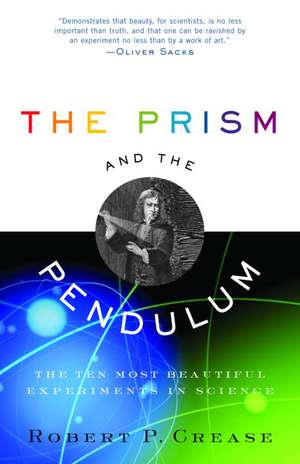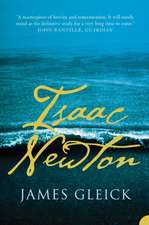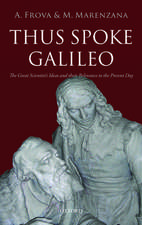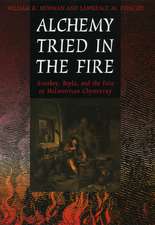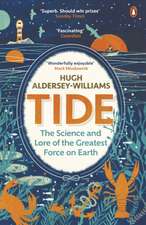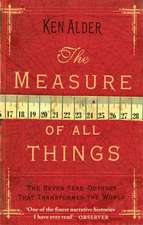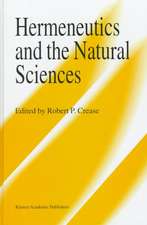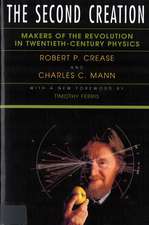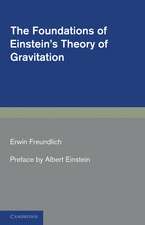The Prism and the Pendulum: The Ten Most Beautiful Experiments in Science
Autor Robert P. Creaseen Limba Engleză Paperback – 30 sep 2004
We see the first measurement of the earth’s circumference, accomplished in the third century B.C. by Eratosthenes using sticks, shadows, and simple geometry. We visit Foucault’s mesmerizing pendulum, a cannonball suspended from the dome of the Panthéon in Paris that allows us to see the rotation of the earth on its axis. We meet Galileo—the only scientist with two experiments in the top ten—brilliantly drawing on his musical training to measure the speed of falling bodies. And we travel to the quantum world, in the most beautiful experiment of all.
We also learn why these ten experiments exert such a powerful hold on our imaginations. From the ancient world to cutting-edge physics, these ten exhilarating moments reveal something fundamental about the world, pulling us out of confusion and revealing nature’s elegance. The Prism and the Pendulum brings us face-to-face with the wonder of science.
From the Hardcover edition.
Preț: 98.78 lei
Nou
Puncte Express: 148
Preț estimativ în valută:
18.90€ • 19.66$ • 15.61£
18.90€ • 19.66$ • 15.61£
Carte disponibilă
Livrare economică 24 martie-07 aprilie
Preluare comenzi: 021 569.72.76
Specificații
ISBN-13: 9780812970623
ISBN-10: 0812970624
Pagini: 272
Ilustrații: 26 B/W CHAPTER-OPENING PHOTOS; DIAGRAMS
Dimensiuni: 132 x 201 x 15 mm
Greutate: 0.3 kg
Ediția:Rh Trade Pbk.
Editura: Random House Trade
ISBN-10: 0812970624
Pagini: 272
Ilustrații: 26 B/W CHAPTER-OPENING PHOTOS; DIAGRAMS
Dimensiuni: 132 x 201 x 15 mm
Greutate: 0.3 kg
Ediția:Rh Trade Pbk.
Editura: Random House Trade
Notă biografică
Robert P. Crease is a professor in the Department of Philosophy at Stony Brook University in New York, and historian at Brookhaven National Laboratory. He writes a monthly column, “Critical Point,” for Physics World magazine. His books include Making Physics: A Biography of Brookhaven National Laboratory; The Play of Nature: Experimentation as Performance; The Second Creation: Makers of the Revolution in Twentieth-Century Physics (with Charles C. Mann); and—with Robert Serber—Peace & War: Reminiscences of a Life on the Frontiers of Science. Crease’s translations include American Philosophy of Technology: The Empirical Turn. He lectures widely, and his articles and reviews have appeared in The Atlantic Monthly, The New York Times Magazine, The Wall Street Journal, Smithsonian, and elsewhere. He lives in New York City.
From the Hardcover edition.
From the Hardcover edition.
Extras
Chapter One
MEASURING THE WORLD: Eratosthenes' Measurement of the Earth's Circumference
IN THE THIRD CENTURY B.C., A GREEK SCHOLAR NAMED Eratosthenes (ca. 276-ca. 195 b.c.) made the first known measurement of the size of the earth. His tools were simple: the shadow cast by the pointer of a sundial, plus a set of measurements and assumptions. But the measurement was so ingenious that it would be cited authoritatively for hundreds of years. It is so simple and instructive that it is reenacted annually, almost 2,500 years later, by schoolchildren all around the globe. And the principle is so elegant that grasping it all but makes you want to go measure the length of a shadow.
Eratosthenes' experiment combined two ideas of far-reaching importance. The first was to picture the cosmos as a set of objects (the earth, sun, planets, and stars) in ordinary three-dimensional space. This may seem obvious to us but was not widely believed then; it was a Greek contribution to science to insist that underneath the myriad, ever-changing motions in the world and in the night sky lay an impersonal and changeless order, a cosmic architecture that could be described and explained by geometry. The second idea was to apply ordinary measurement practices to understand the scope and dimensions of this cosmic architecture. In combining these two ideas, Eratosthenes came up with the audacious notion that the same techniques that had been developed for building houses and bridges, laying out fields and roads, and predicting floods and monsoons could provide information about the dimensions of the earth and other heavenly bodies.
Eratosthenes began by assuming that the earth was approximately round. For despite the widespread contemporary belief that Columbus set out to prove that the world was not flat, many of the ancient Greeks who had thought carefully about the cosmos had already concluded that the earth not only had to be round, but also that it must be relatively tiny in comparison with the rest of the universe. Among these scholars was Aristotle, whose book On the Heavens, written about a century before Eratosthenes, advanced several different arguments, some logical and some empirical, for why the earth had to be spherical. Aristotle pointed out, for instance, that during eclipses the shadow cast by the earth on the moon is always curved-something that would occur only if the earth were round. He also noted that travelers see different stars when going north or south (unlikely if the world is flat), that certain stars visible in Egypt and Cyprus cannot be seen in more northern lands, and that certain other stars always visible in the north rise and set in the south, as if they were seen at a distance from the surface of a round object. "This indicates not only that the earth's mass is spherical in shape," Aristotle wrote, "but also that as compared with the stars it is not of great size."
But the resourceful thinker also offered more creative arguments. From accounts by foreign travelers and military expeditions, he knew that elephants were found in distant lands both to the east (Africa) and to the west (Asia). Therefore, he said, these lands are probably joined-a clever if incorrect guess. Other Greek scholars made additional arguments for the earth's spherical shape, including the difference in the time of sunrise and sunset in different countries, and the way departing ships gradually fall out of sight from the hull upward.
None of this, though, answered a basic question: How big is this round earth? Was it even possible to know its size, without having surveyors actually pace over its entire circumference?
Until Eratosthenes, we know of only estimates of the earth's size. The earliest is by Aristotle, who wrote that "those mathematicians who try to calculate the size of the Earth's circumference arrive at the figure 400,000 stades," but he did not tell us either his sources or their reasoning. It is also impossible to convert his figure precisely to modern units. A stade, or "stadium," referred to the length of a Greek racetrack, which varied from city to city. By using a rough estimate for the stade, today's researchers have put Aristotle's figure at somewhat more than 40,000 miles (the actual number is about 24,900 miles). Archimedes, who built models of the cosmos in which the heavenly bodies revolved around one another, gave a slightly smaller estimate than Aristotle's: 300,000 stades, or more than 30,000 miles. But he, too, provided no clue to his source or reasoning.
Enter Eratosthenes. A younger contemporary of Archimedes, Eratosthenes was born in North Africa and educated in Athens. He was a polymath, expert in many areas from literary criticism and poetry to geography and mathematics. But he was not thought to have achieved the first rank in any, which led associates to give him the sarcastic nickname "Beta," the second letter of the Greek alphabet, in a joke meaning he was always second best. Despite the gibes, his brilliance was so renowned that in the middle of the third century b.c. the king of Egypt invited Eratosthenes to tutor his son, and later appointed him to head the famous library at Alexandria. This was the first and largest library of its kind, and had been established by the Ptolemys, the kings of Egypt, in the course of building up Alexandria as the cultural capital of the Greek world. The library became a meeting point for scholars around the world, and Alexandria grew into an important intellectual crossroads-it was home to Euclid and his school, for instance. At Alexandria, the librarians were able to amass a comprehensive collection of manuscripts on a wide range of subjects that anyone with the appropriate scholarly credentials could use. (The Alexandrian library was also the first one known to have arranged manuscripts by author in alphabetical order.)
Eratosthenes wrote two books on geography that were of particular importance in the ancient world. Geographica, a three-volume set, was the first to map the world using parallels (lines parallel to the equator) and meridians (longitudinal lines, which pass through both poles and a given location). His Measurement of the World contained the first known description of a way to measure the size of the earth. Unfortunately, both works have been lost, and we have to reconstruct Eratosthenes' reasoning from the remarks of other ancient authors who knew them. Fortunately, many did.
Eratosthenes began by reasoning that if the earth were a small, spherical body in a vast universe, then other parts, such as the sun, must be far away-so far away that its rays were essentially parallel no matter where they struck the earth. He also knew that as the sun crept upward in the sky, shadows grew progressively shorter-and he knew from travelers' reports that on the summer solstice in the town of Syene (modern-day Aswan), the sun stood directly overhead, and shadows would disappear around anything vertical, including columns, poles, and even gnomons, the vertical indicators or pointers in sundials, whose sole function was to cast shadows. Shadows even seemed to disappear from the town well as the light flooded it uniformly, "like a stopper fitting evenly all round to the mouth," according to one ancient source. (I exaggerate a little; the shadows did not disappear completely, but simply fell straight below objects, rather than off to the side as they usually do.)
Furthermore, Eratosthenes knew that Alexandria was north of Syene and roughly on the same meridian. And thanks to the royal surveyors, whom the Egyptian government sent to pace and remap the land each year after the seasonal flooding of the Nile, he knew that the two towns were about five thousand stades apart (the number was rounded off, so we cannot use this information to establish a precise equivalent between stades and modern units).
In modern terms, Syene was on the Tropic of Cancer, an imaginary line around the world that passes through northern Mexico, southern Egypt, India, and southern China (it is shown on most globes). All the points on the tropic share a single unusual feature: The sun is directly overhead only once a year, on the longest day of the year-June 21, the summer solstice. People who live north of the Tropic of Cancer never see the sun directly overhead, and the sun always casts a shadow. People in the northern hemisphere who live south of it see the sun directly overhead twice a year, once before the solstice and once after, with the exact day depending on the location.
The reason for this has to do with the position of the earth, whose axis is tilted with respect to the sun. But this did not concern Eratosthenes. What mattered to him was that when the sun was directly overhead at Syene, it would not be overhead anywhere to the north or south-including Alexandria-and a gnomon would cast a shadow in those places. How long a shadow would depend on the amount of the earth's curvature; if the curvature were great, a shadow in a place like Alexandria would be longer than if the earth's curvature were slight.
Thanks to his geometrical knowledge, Eratosthenes knew enough to devise an ingenious experiment that would tell him the exact amount of curvature, and so the circumference of the earth.
To appreciate the beauty of this experiment, we do not need to know anything about the specific way Eratosthenes went about it. This is lucky, for we do not even have his description of what he did. We know it only through incomplete secondhand descriptions by his contemporaries and successors, most of whom clearly did not understand all its details. We do not need to know anything about his path of inquiry-what specifically motivated his interest in this problem, what his initial steps were, what backtracks, if any, he made, how he achieved the final realization, and in what further directions he was led. This is unfortunate, for it may create the impression that the idea came to him as a brainstorm, a bolt from the blue, but it does not impede our ability to understand the experiment. Nor are we required to engage in speculative intellectual leaps, to follow complex mathematical reasoning, or to employ clever empirical guesses based on things like elephant demographics. The beauty of his experiment lies in the way it makes possible the discovery of a dimension of cosmic proportions by measuring the length of a tiny shadow.
Its breathtaking simplicity and elegance can be captured in two diagrams:
During the solstice, when the sun is directly overhead at Syene (A), shadows disappeared-they fell straight toward the center of the earth (line AB). Meanwhile, the shadows at Alexandria (E) also fell in the same direction (CD), because the sun's rays are parallel; but because the earth is curved they fell at a slight angle, which we'll call X. A small angle or short shadow would mean that the earth's curvature was relatively flat and that the earth had a large circumference; a large angle or long shadow would mean a sharp curvature and a small circumference. Was there a way to figure out the circumference exactly by the length of the shadow? Geometry provided a way.
According to Euclid, the interior angles of a line that intersects two parallel lines are equal. Thus the angle cast by shadows in Alexandria (X) is equal to the angle (Y) created by the two rays whose vertex is at the center of the earth and that pass through Alexandria and Syene (BE and BA). This in turn means that the ratio between the length of the arc of a gnomon (CE) and of the complete circle around the gnomon (see Figure 2.2) is the same as the ratio between the distance from Syene to Alexandria (AE) and the earth's circumference. If one measured this fraction, Eratosthenes realized, one could calculate the earth's circumference.
Although Eratosthenes might have made his measurement in a number of ways, historians of science are fairly sure he did it with an hour-counter, the Greek version of a sundial, because the arc of its shadow would be sharply defined. An hour-counter, or skaphe, consisted of a bronze bowl equipped with a gnomon, whose shadow crept slowly across hour-lines cut into the bowl's surface. But Eratosthenes used this piece of equipment in a new way. He was not interested in the position of the shadow on the hour-lines to track the passage of time, but rather in the angle of the shadow cast by the gnomon at noon on the summer solstice. He would measure what fraction that angle was of a complete circle (the practice of measuring in degrees obtained by dividing a circle into 360 equal parts would not become standard for about another century). Or, in what amounts to the same thing, he might have measured the ratio of the length of the arc cast by the gnomon on the bowl to the full circumference of the bowl.
At noon on that day, Eratosthenes ascertained that the shadow's wedge was 1Ž50th of a complete circle (we would say 7.2 degrees). The distance between Alexandria and Syene was therefore a fiftieth of the distance around the entire meridian. Multiplying 5,000 stades by 50, he got 250,000 stades as the earth's circumference; later, he adjusted this to 252,000 stades (both work out to just over 25,000 miles). The reason for this adjustment is not clear, but probably had to do with his desire to simplify the calculation of geographical distances. For Eratosthenes was in the habit of dividing circles into sixty parts, and a circumference of 252,000 stades made for an even 4,200 stades per each sixtieth part of the circle. But whether one uses 250,000 or 252,000 stades, and whichever figure one trusts for converting his stades into modern units of distance, his estimate lies within just a few percent of the figure in use today of 24,900 miles.
Eratosthenes' picture of the cosmos was critical to the success of the experiment. Without this particular picture, measuring the shadow would not yield the earth's circumference. For example, an ancient Chinese cartographic text, the Huainanzi, or "Book of the Master of Huainan," notes that gnomons of the same height but at different (north-south) distances from one another cast shadows of different lengths at the same time. On the assumption that the earth is essentially flat, the author attributed this difference to the fact that the gnomon casting the narrower shadow is more directly under the sun, and argues that the difference in shadow lengths can be used to calculate the height of the sky!
Eratosthenes' data, and his measurement, were approximate. He was probably aware that Syene is not precisely on the Tropic of Cancer. Nor does it lie exactly due south of Alexandria. The distance between the two towns is not exactly five thousand stades. And because the sun is not a point of light but a little disc (about half a degree wide), the light from one side of the disc does not strike the gnomon at exactly the same angle as the light on the other side, smearing the shadow slightly.
From the Hardcover edition.
MEASURING THE WORLD: Eratosthenes' Measurement of the Earth's Circumference
IN THE THIRD CENTURY B.C., A GREEK SCHOLAR NAMED Eratosthenes (ca. 276-ca. 195 b.c.) made the first known measurement of the size of the earth. His tools were simple: the shadow cast by the pointer of a sundial, plus a set of measurements and assumptions. But the measurement was so ingenious that it would be cited authoritatively for hundreds of years. It is so simple and instructive that it is reenacted annually, almost 2,500 years later, by schoolchildren all around the globe. And the principle is so elegant that grasping it all but makes you want to go measure the length of a shadow.
Eratosthenes' experiment combined two ideas of far-reaching importance. The first was to picture the cosmos as a set of objects (the earth, sun, planets, and stars) in ordinary three-dimensional space. This may seem obvious to us but was not widely believed then; it was a Greek contribution to science to insist that underneath the myriad, ever-changing motions in the world and in the night sky lay an impersonal and changeless order, a cosmic architecture that could be described and explained by geometry. The second idea was to apply ordinary measurement practices to understand the scope and dimensions of this cosmic architecture. In combining these two ideas, Eratosthenes came up with the audacious notion that the same techniques that had been developed for building houses and bridges, laying out fields and roads, and predicting floods and monsoons could provide information about the dimensions of the earth and other heavenly bodies.
Eratosthenes began by assuming that the earth was approximately round. For despite the widespread contemporary belief that Columbus set out to prove that the world was not flat, many of the ancient Greeks who had thought carefully about the cosmos had already concluded that the earth not only had to be round, but also that it must be relatively tiny in comparison with the rest of the universe. Among these scholars was Aristotle, whose book On the Heavens, written about a century before Eratosthenes, advanced several different arguments, some logical and some empirical, for why the earth had to be spherical. Aristotle pointed out, for instance, that during eclipses the shadow cast by the earth on the moon is always curved-something that would occur only if the earth were round. He also noted that travelers see different stars when going north or south (unlikely if the world is flat), that certain stars visible in Egypt and Cyprus cannot be seen in more northern lands, and that certain other stars always visible in the north rise and set in the south, as if they were seen at a distance from the surface of a round object. "This indicates not only that the earth's mass is spherical in shape," Aristotle wrote, "but also that as compared with the stars it is not of great size."
But the resourceful thinker also offered more creative arguments. From accounts by foreign travelers and military expeditions, he knew that elephants were found in distant lands both to the east (Africa) and to the west (Asia). Therefore, he said, these lands are probably joined-a clever if incorrect guess. Other Greek scholars made additional arguments for the earth's spherical shape, including the difference in the time of sunrise and sunset in different countries, and the way departing ships gradually fall out of sight from the hull upward.
None of this, though, answered a basic question: How big is this round earth? Was it even possible to know its size, without having surveyors actually pace over its entire circumference?
Until Eratosthenes, we know of only estimates of the earth's size. The earliest is by Aristotle, who wrote that "those mathematicians who try to calculate the size of the Earth's circumference arrive at the figure 400,000 stades," but he did not tell us either his sources or their reasoning. It is also impossible to convert his figure precisely to modern units. A stade, or "stadium," referred to the length of a Greek racetrack, which varied from city to city. By using a rough estimate for the stade, today's researchers have put Aristotle's figure at somewhat more than 40,000 miles (the actual number is about 24,900 miles). Archimedes, who built models of the cosmos in which the heavenly bodies revolved around one another, gave a slightly smaller estimate than Aristotle's: 300,000 stades, or more than 30,000 miles. But he, too, provided no clue to his source or reasoning.
Enter Eratosthenes. A younger contemporary of Archimedes, Eratosthenes was born in North Africa and educated in Athens. He was a polymath, expert in many areas from literary criticism and poetry to geography and mathematics. But he was not thought to have achieved the first rank in any, which led associates to give him the sarcastic nickname "Beta," the second letter of the Greek alphabet, in a joke meaning he was always second best. Despite the gibes, his brilliance was so renowned that in the middle of the third century b.c. the king of Egypt invited Eratosthenes to tutor his son, and later appointed him to head the famous library at Alexandria. This was the first and largest library of its kind, and had been established by the Ptolemys, the kings of Egypt, in the course of building up Alexandria as the cultural capital of the Greek world. The library became a meeting point for scholars around the world, and Alexandria grew into an important intellectual crossroads-it was home to Euclid and his school, for instance. At Alexandria, the librarians were able to amass a comprehensive collection of manuscripts on a wide range of subjects that anyone with the appropriate scholarly credentials could use. (The Alexandrian library was also the first one known to have arranged manuscripts by author in alphabetical order.)
Eratosthenes wrote two books on geography that were of particular importance in the ancient world. Geographica, a three-volume set, was the first to map the world using parallels (lines parallel to the equator) and meridians (longitudinal lines, which pass through both poles and a given location). His Measurement of the World contained the first known description of a way to measure the size of the earth. Unfortunately, both works have been lost, and we have to reconstruct Eratosthenes' reasoning from the remarks of other ancient authors who knew them. Fortunately, many did.
Eratosthenes began by reasoning that if the earth were a small, spherical body in a vast universe, then other parts, such as the sun, must be far away-so far away that its rays were essentially parallel no matter where they struck the earth. He also knew that as the sun crept upward in the sky, shadows grew progressively shorter-and he knew from travelers' reports that on the summer solstice in the town of Syene (modern-day Aswan), the sun stood directly overhead, and shadows would disappear around anything vertical, including columns, poles, and even gnomons, the vertical indicators or pointers in sundials, whose sole function was to cast shadows. Shadows even seemed to disappear from the town well as the light flooded it uniformly, "like a stopper fitting evenly all round to the mouth," according to one ancient source. (I exaggerate a little; the shadows did not disappear completely, but simply fell straight below objects, rather than off to the side as they usually do.)
Furthermore, Eratosthenes knew that Alexandria was north of Syene and roughly on the same meridian. And thanks to the royal surveyors, whom the Egyptian government sent to pace and remap the land each year after the seasonal flooding of the Nile, he knew that the two towns were about five thousand stades apart (the number was rounded off, so we cannot use this information to establish a precise equivalent between stades and modern units).
In modern terms, Syene was on the Tropic of Cancer, an imaginary line around the world that passes through northern Mexico, southern Egypt, India, and southern China (it is shown on most globes). All the points on the tropic share a single unusual feature: The sun is directly overhead only once a year, on the longest day of the year-June 21, the summer solstice. People who live north of the Tropic of Cancer never see the sun directly overhead, and the sun always casts a shadow. People in the northern hemisphere who live south of it see the sun directly overhead twice a year, once before the solstice and once after, with the exact day depending on the location.
The reason for this has to do with the position of the earth, whose axis is tilted with respect to the sun. But this did not concern Eratosthenes. What mattered to him was that when the sun was directly overhead at Syene, it would not be overhead anywhere to the north or south-including Alexandria-and a gnomon would cast a shadow in those places. How long a shadow would depend on the amount of the earth's curvature; if the curvature were great, a shadow in a place like Alexandria would be longer than if the earth's curvature were slight.
Thanks to his geometrical knowledge, Eratosthenes knew enough to devise an ingenious experiment that would tell him the exact amount of curvature, and so the circumference of the earth.
To appreciate the beauty of this experiment, we do not need to know anything about the specific way Eratosthenes went about it. This is lucky, for we do not even have his description of what he did. We know it only through incomplete secondhand descriptions by his contemporaries and successors, most of whom clearly did not understand all its details. We do not need to know anything about his path of inquiry-what specifically motivated his interest in this problem, what his initial steps were, what backtracks, if any, he made, how he achieved the final realization, and in what further directions he was led. This is unfortunate, for it may create the impression that the idea came to him as a brainstorm, a bolt from the blue, but it does not impede our ability to understand the experiment. Nor are we required to engage in speculative intellectual leaps, to follow complex mathematical reasoning, or to employ clever empirical guesses based on things like elephant demographics. The beauty of his experiment lies in the way it makes possible the discovery of a dimension of cosmic proportions by measuring the length of a tiny shadow.
Its breathtaking simplicity and elegance can be captured in two diagrams:
During the solstice, when the sun is directly overhead at Syene (A), shadows disappeared-they fell straight toward the center of the earth (line AB). Meanwhile, the shadows at Alexandria (E) also fell in the same direction (CD), because the sun's rays are parallel; but because the earth is curved they fell at a slight angle, which we'll call X. A small angle or short shadow would mean that the earth's curvature was relatively flat and that the earth had a large circumference; a large angle or long shadow would mean a sharp curvature and a small circumference. Was there a way to figure out the circumference exactly by the length of the shadow? Geometry provided a way.
According to Euclid, the interior angles of a line that intersects two parallel lines are equal. Thus the angle cast by shadows in Alexandria (X) is equal to the angle (Y) created by the two rays whose vertex is at the center of the earth and that pass through Alexandria and Syene (BE and BA). This in turn means that the ratio between the length of the arc of a gnomon (CE) and of the complete circle around the gnomon (see Figure 2.2) is the same as the ratio between the distance from Syene to Alexandria (AE) and the earth's circumference. If one measured this fraction, Eratosthenes realized, one could calculate the earth's circumference.
Although Eratosthenes might have made his measurement in a number of ways, historians of science are fairly sure he did it with an hour-counter, the Greek version of a sundial, because the arc of its shadow would be sharply defined. An hour-counter, or skaphe, consisted of a bronze bowl equipped with a gnomon, whose shadow crept slowly across hour-lines cut into the bowl's surface. But Eratosthenes used this piece of equipment in a new way. He was not interested in the position of the shadow on the hour-lines to track the passage of time, but rather in the angle of the shadow cast by the gnomon at noon on the summer solstice. He would measure what fraction that angle was of a complete circle (the practice of measuring in degrees obtained by dividing a circle into 360 equal parts would not become standard for about another century). Or, in what amounts to the same thing, he might have measured the ratio of the length of the arc cast by the gnomon on the bowl to the full circumference of the bowl.
At noon on that day, Eratosthenes ascertained that the shadow's wedge was 1Ž50th of a complete circle (we would say 7.2 degrees). The distance between Alexandria and Syene was therefore a fiftieth of the distance around the entire meridian. Multiplying 5,000 stades by 50, he got 250,000 stades as the earth's circumference; later, he adjusted this to 252,000 stades (both work out to just over 25,000 miles). The reason for this adjustment is not clear, but probably had to do with his desire to simplify the calculation of geographical distances. For Eratosthenes was in the habit of dividing circles into sixty parts, and a circumference of 252,000 stades made for an even 4,200 stades per each sixtieth part of the circle. But whether one uses 250,000 or 252,000 stades, and whichever figure one trusts for converting his stades into modern units of distance, his estimate lies within just a few percent of the figure in use today of 24,900 miles.
Eratosthenes' picture of the cosmos was critical to the success of the experiment. Without this particular picture, measuring the shadow would not yield the earth's circumference. For example, an ancient Chinese cartographic text, the Huainanzi, or "Book of the Master of Huainan," notes that gnomons of the same height but at different (north-south) distances from one another cast shadows of different lengths at the same time. On the assumption that the earth is essentially flat, the author attributed this difference to the fact that the gnomon casting the narrower shadow is more directly under the sun, and argues that the difference in shadow lengths can be used to calculate the height of the sky!
Eratosthenes' data, and his measurement, were approximate. He was probably aware that Syene is not precisely on the Tropic of Cancer. Nor does it lie exactly due south of Alexandria. The distance between the two towns is not exactly five thousand stades. And because the sun is not a point of light but a little disc (about half a degree wide), the light from one side of the disc does not strike the gnomon at exactly the same angle as the light on the other side, smearing the shadow slightly.
From the Hardcover edition.
Recenzii
“Science and scientists are so often seen as cold and emotionless, but they are passionately drawn to beauty and truth, no less intensely than artists or poets. One can open this book anywhere and get a sense of this special passion—each chapter has its own special feel and delectations, and all of them bring out that beauty, for scientists, is no less important than truth, and that one can be ravished by an experiment no less than by a work of art.”
—Oliver Sacks
“In an era in which the public perceives science as a string of ethereal ideas conjured up by cute men in tweed jackets sitting in overstuffed leather chairs in the faculty lounge, The Prism and the Pendulum creates a refreshing portrait of beauty in science: of men with rough hands polishing inclined planes, peering into wells, climbing towers, or sitting in the dark looking for the one spark in eight thousand that would ignite the nuclear age. In this readable, narrative-driven book, we meet scientists wresting the truth from nature by confronting her on a physical, visceral level. Robert Crease, with this volume, destroys and corrects the ‘damn good stories’ commonly used to teach science, and places himself among our most important science historians and philosophers.”
—Dick Teresi, author of Lost Discoveries, coauthor of The God Particle, cofounder of Omni
From the Hardcover edition.
—Oliver Sacks
“In an era in which the public perceives science as a string of ethereal ideas conjured up by cute men in tweed jackets sitting in overstuffed leather chairs in the faculty lounge, The Prism and the Pendulum creates a refreshing portrait of beauty in science: of men with rough hands polishing inclined planes, peering into wells, climbing towers, or sitting in the dark looking for the one spark in eight thousand that would ignite the nuclear age. In this readable, narrative-driven book, we meet scientists wresting the truth from nature by confronting her on a physical, visceral level. Robert Crease, with this volume, destroys and corrects the ‘damn good stories’ commonly used to teach science, and places himself among our most important science historians and philosophers.”
—Dick Teresi, author of Lost Discoveries, coauthor of The God Particle, cofounder of Omni
From the Hardcover edition.
